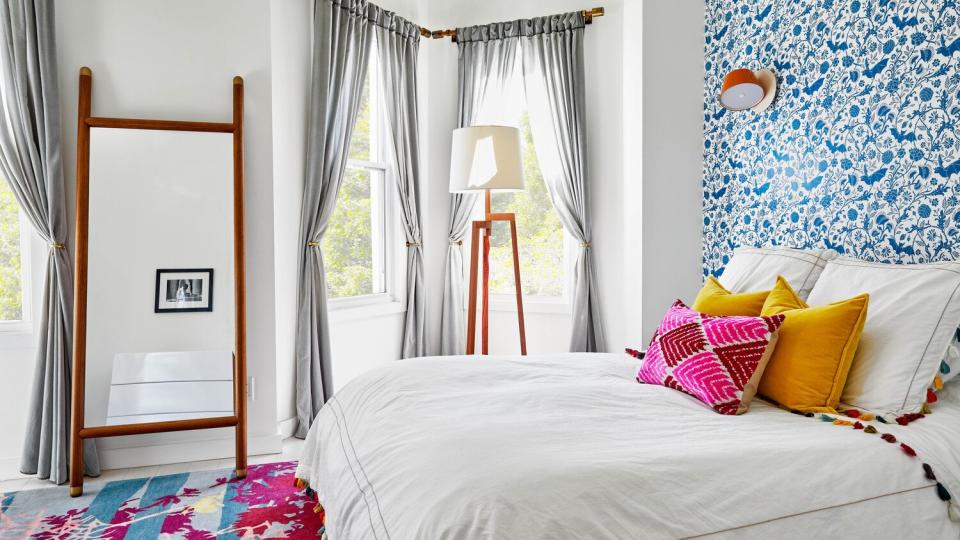How to Choose the Best Curtains for Your Bedroom
When it comes to choosing bedroom curtains, factors to consider go beyond aesthetics. The interior design choices you make in your bedroom can affect your sleep, which, in turn, impacts your physical and mental health. According to studies, light is the most important external factor affecting sleep—making bedroom curtains all the more important for a good night's rest.
Curtains not only tie the room together, but they can also play a role in our circadian rhythm, which is our internal clock that tells our body when it's time to rest. Bottom line? Don't underestimate the power of bedroom curtains. We spoke with three experts—Meg Piercy, founder and owner of MegMade, Kathryn Emery, home improvement and lifestyle expert, and Brooke McReynolds, senior luxe designer at Modsy—and asked for their best advice on choosing curtains for the bedroom. Ahead, we've broken the process down for you based on fabric, color, style, and more.
First, a few general tips. "As a rule, curtains should be mounted four to six inches above your window frame," says Emery. "Curtains are sold in three lengths: 108 inches, 96 inches, and 84 inches. If a standard size doesn't work for you, you'll want something customizable." Blackout privacy curtains are typically preferred for the bedroom, "especially in rooms for small children or people who are photosensitive," says Piercy. "But you can always add a roman blackout shade to go behind your curtains if you'd like them to have a light and airy feel."
Related: Living Room Curtain Ideas for Every Style of Home

Choosing the Best Fabric
When choosing bedroom curtains, start with material—cotton is the most common option. "Cotton is light, breathable, and easy to care for," says Emery. Opt for a machine-washable fabric if you prefer convenience. However, if you want a luxury vibe, consider a heavier, more sumptuous fabric. Textured fabrics—like silk—are a great choice. "Silk lets light through for an airy, luxurious appearance. However, it's harder to care for and is on the expensive side," says Emery. "Silk will show water and UV damage faster than other fabrics," adds Piercy, so it's important to keep this in mind when shopping. Of course, one of the most elevated ideas for bedroom curtains is velvet. "Velvet is heavy and excellent for insulating your windows from cold drafts and hot summer days," explains Emery. "It's ideal for late sleepers or rooms with direct sunlight," adds McReynolds. And while it's a great privacy fabric, "velvet accumulates dust easily," says Piercy, so be warned that this type of drape needs more upkeep.
If you're looking for a style that's as easy on your pocket as it is on the eyes, go for polyester. "Polyester is budget-friendly, low-maintenance, and great for first-time homebuyers," says McReynolds. "Although, the fabric is flammable and absorbs odors." This seems like a con—but your bedroom is one of the least likely rooms to have open flames or pungent odors, unlike say, your kitchen. Opt for linen bedroom curtains if a light, environmentally-friendly style is more your preference. "Linen is eco-friendly and is known to prevent the growth of bacteria and fungi. If your bedroom tends to be on the damper side, this is a great option," says McReynolds. The only cons? "It's more expensive than cotton and can wrinkle easily," explains Emery.
Consider Color and Pattern
"Think about what colors will complement your space," says Piercy. "In most cases, cool-toned colors pair well with other cool-tones, and vice versa." Emery suggests avoiding bright colors if your bedroom is drenched in sunlight. "Natural light will fade color over time," she explains. As for patterned curtains, McReynolds says it's best to think of them as wall art. "Patterned curtains can have the same effect as a piece of art when completely drawn, so keep that in mind during the selection process," she says.
Remember the Hardware
"I like to choose a thicker curtain rod because it can hold the weight of any fabric and it gives off a more elevated look," says Piercy. As for hardware finishes, "the fixtures should blend in with the curtains," says Emery. "Silky or satin drapes pair well with wrought iron or wood, while rough linen curtains are nicely accented with wood or metal finishes."
Headers Are Important, Too
There are a number of headers on curtains that can add to the dimension of your window treatments. McReynolds outlines the different styles, starting with pinch pleats. "This is a classic look that's perfect for elegant and traditional-style bedrooms." Or use grommets, says McReynolds, "This header features metal rings attached to the top of the fabric that the rod is then inserted into." Finally, the third option are gathers. "This header style is a standard gather that has undefined pleats along the top of the curtain. It's a more informal look, and it's great for smaller windows."

